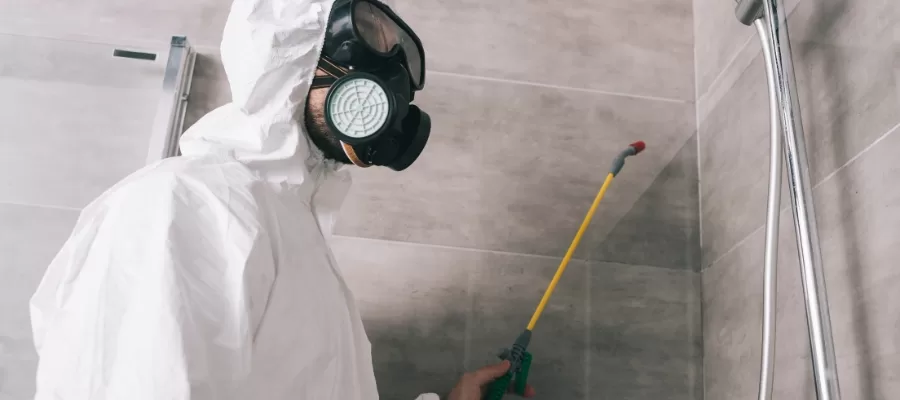Still seeing silverfish even after trying every spray, trap, or online hack you could find? You’re not alone, and you’re not doing anything wrong. These pests are notoriously stubborn, and by the time you notice them, the infestation is often worse than it looks. If you’ve reached the point where DIY methods just aren’t cutting it, searching for a silverfish exterminator near you is the right next step.
In Costa Mesa, homeowners trust Wipe Out Pest Control for fast, professional, and lasting results. We know where silverfish hide, how they spread, and most importantly how to eliminate them for good. Relief is closer than you think. Let’s solve this for real.
Why Silverfish Thrive in Costa Mesa Homes
Silverfish aren’t just a random pest problem, they’re a byproduct of Costa Mesa’s climate and architecture.
Humidity is the big trigger
Our coastal air holds moisture year-round, even when it doesn’t feel damp. Silverfish feed off that. Bathrooms, closets, attics, even dry-looking areas, can trap enough humidity to create perfect breeding grounds. And since Costa Mesa rarely gets harsh cold, these pests don’t die off in winter. They just keep multiplying.
Certain home features make things worse
Older houses with wooden baseboards, crawl spaces, or Spanish-style clay roofs often have tiny gaps and hidden pockets of warmth and moisture. These are prime spots for silverfish to hide and lay eggs. They squeeze into cracks no wider than a credit card and stay out of sight for months.
But newer homes aren’t safe either
Modern insulation is excellent at sealing in comfort, but it also traps moisture in enclosed spaces. Add to that closed storage, cardboard boxes, or laundry rooms without proper airflow, and you’ve got a pest magnet.
In Costa Mesa, silverfish aren’t a fluke. They’re part of the environment. The good news? Knowing how and why they thrive is the first step to kicking them out for good.
How Silverfish Behavior Catches Homeowners Off Guard
Silverfish aren’t loud, aggressive, or obviously destructive—and that’s exactly what makes them dangerous.
They don’t bite or buzz
There’s no warning sound, no sting, nothing dramatic to alert you. But behind the scenes, they’re eating through paper, glue, fabric, and cardboard. You don’t notice until you open a book and find chewed pages, or pull out holiday decorations and discover shredded boxes.
They’re flat-bodied and nocturnal
Silverfish stay hidden during the day and move silently at night. Their slim shape lets them slide under baseboards, behind walls, and into storage bins without leaving visible traces. That’s why most homeowners never see them, until they turn on a light at 2 a.m. and spot one darting across the bathroom floor.
By the time you see one, damage is already done
A visible silverfish usually means dozens more are hiding. Their eggs are tucked into cracks and crevices, and infestations build slowly until entire areas of your home are quietly compromised.
What makes silverfish scary isn’t what they do in plain sight. It’s what they destroy while staying invisible.
DIY Methods Homeowners Regret Trying
If you’ve tried to handle silverfish on your own, you’re not alone. Most Costa Mesa homeowners start with DIY tricks, only to find the problem worse a month later.
Baking soda, cedar oil, and store-bought traps seem promising, especially with the hundreds of home remedy blogs out there. But here’s the truth: these methods kill a few surface bugs at best. They don’t touch the real issue—eggs hidden deep in cracks, colonies nesting behind your walls, or the constant humidity drawing silverfish back in.
One Costa Mesa resident shared that after sprinkling baking soda around baseboards, they saw fewer bugs for a few days, then suddenly found them in the closet and guest room. Another used essential oil sprays weekly but noticed new damage in a sealed box of winter clothes. These aren’t flukes, they’re examples of what happens when treatment only scratches the surface.
The bigger problem? Half-solutions spread the infestation. When you disturb silverfish without fully eliminating them, they scatter. What started in one bathroom can end up in your garage, linen closet, or attic. You think you’re solving the issue, but you’re actually giving it more square footage.
DIY attempts often make homeowners feel like they’ve taken action—but in reality, they delay real results. Meanwhile, silverfish continue laying eggs, eating through valuables, and expanding into untouched parts of the home.
When it comes to silverfish, temporary fixes don’t work. If you’ve already tried sprays, powders, or traps and they keep coming back, it’s not your fault. These pests are designed to outlast surface-level solutions. That’s why effective removal takes a deeper, targeted approach—one that only trained professionals can deliver.
Inside a Silverfish Inspection: What the Pros Look For
A professional silverfish inspection isn’t just about spotting bugs—it’s about uncovering the hidden conditions that allow them to thrive.
It starts with moisture mapping
Silverfish love damp, humid spaces, so technicians begin by scanning for moisture hotspots behind walls, under sinks, and near plumbing lines. Even small leaks or condensation behind drywall can create the perfect breeding ground. These are places most homeowners never think to check, yet they’re often the root of the infestation.
Next, they search where you’d never think to look
Attic insulation might seem dry and useless to pests, but it’s warm, dark, and often full of undisturbed materials like cardboard or paper, prime nesting zones. Technicians will dig through boxes, inspect insulation layers, and check storage shelves where silverfish quietly multiply.
But it’s not just about where—they know what signs to follow
Professionals are trained to spot subtle clues: fine dust near baseboards (a sign of feeding), yellow stains on stored fabric, tiny cast-off skins, or even changes in airflow patterns that suggest hidden humidity. These aren’t things most people notice, but they’re red flags to an experienced eye.
The goal of a pro inspection isn’t just to confirm the presence of silverfish. It’s to map their movement, find their entry points, and understand what’s keeping them comfortable. That’s what allows for precise, targeted treatment that actually lasts.
A surface-level look won’t cut it. To wipe out silverfish for good, you need a strategy built on what’s happening behind the walls and that starts with a real inspection by someone who knows what to look for.
Why Wipe Out Pest Control Stands Out in Costa Mesa
When you’re dealing with a silverfish infestation, you need more than just a quick spray—you need a team that understands your home, your concerns, and your urgency. Here’s what sets Wipe Out Pest Control apart from the rest:
- Fast, local response
We’re based right here in Orange County and often provide same-day service for Costa Mesa residents. - No contracts or hidden fees
You’ll never be pressured into long-term agreements or hit with surprise charges. We offer honest, upfront pricing every time. - Respectful, professional technicians
Our team shows up on time, in uniform, and takes the time to explain what they’re doing and why. - Follow-up that actually happens
We don’t treat and vanish. We follow up, track results, and adjust treatments if needed to make sure the problem stays gone. - Tailored treatment plans
Every home is different. We customize our approach based on your layout, moisture levels, and severity of infestation. - Safe for families and pets
We use products that are tough on pests but safe for your loved ones—so you don’t have to choose between results and peace of mind. - Deep knowledge of Costa Mesa’s pest patterns
From beachside condos to older homes inland, we understand how local conditions influence pest activity and we target accordingly. - Great local reputation
We’ve built trust one homeowner at a time, with reviews that reflect our dedication to quality and consistency. - Support beyond the treatment
We’ll offer tips on moisture control, sealing entry points, and keeping your home silverfish-free long after we’re gone.
Choosing Wipe Out means you’re not just hiring an exterminator, you’re partnering with a team that actually cares about solving your pest problem the right way.
Treatment Without the Guesswork: What Works Long-Term
Killing a few visible silverfish with one spray isn’t successIt’s a short-term win that won’t stop the next wave.
That’s why integrated treatment is the standard now
Silverfish infestations aren’t solved with a single product. Pros use a layered strategy that tackles pests at every stage of life: eggs, active adults, and hidden colonies. It’s the only way to break the cycle and keep them from coming back.
Smart gel placements and residual powders do the heavy lifting
Gels attract silverfish into bait zones, while powders are applied in cracks, behind baseboards, and inside wall voids places silverfish travel at night. Unlike sprays that wear off fast, these products keep working for weeks, eliminating bugs that never show themselves during the day.
The key difference? Knockdown vs. wipeout
Knockdown treatments might give you relief for a week or two. But if eggs survive or the root moisture problem isn’t addressed you’ll be back to square one. A wipeout approach is different. It includes follow-up inspections, home environment adjustments (like sealing entry points or recommending dehumidifiers), and strategic product use designed for long-term suppression.
Think of it like treating the cause instead of just the symptom. Real silverfish control means cutting off their ability to thrive ,not just chasing them around with a spray can.
If you’ve done quick fixes before and they didn’t last, it’s not because the bugs are invincible. It’s because you weren’t using a complete system. That’s what professional treatment delivers and why it’s the only reliable way to clear them out for good.
How to Prevent Silverfish After Treatment
Once the silverfish are gone, keeping them out is all about making your home less inviting. Here’s how to stay pest-free:
- Run dehumidifiers in damp areas
Bathrooms, basements, and laundry rooms are silverfish hotspots. Keeping humidity low makes these areas less hospitable. - Seal up cracks and gaps
Use caulk or weatherstripping to close off entry points around baseboards, pipes, vents, and wall seams, anywhere silverfish can slip through. - Store paper and fabric items properly
Keep books, documents, seasonal clothes, and linens in airtight bins instead of cardboard boxes. Silverfish love paper and fabric for both food and nesting. - Maintain a clean, dry environment
Vacuum regularly, fix any leaks quickly, and keep clutter to a minimum. Well-ventilated, tidy homes are much harder for pests to infest.
With these steps, you’ll not only protect your home after treatment you’ll make sure silverfish never feel welcome again.
Conclusion: Let’s Help You Wipe Them Out
If you’ve made it this far, you’re probably tired of seeing silverfish dart across your floors or ruin your belongings. Stop Googling “silverfish exterminator near me” and get help that actually works. At Wipe Out Pest Control, we make the process easy: no-pressure service, no hidden fees, just real results.
We offer free inspections, fast response times in Costa Mesa, and treatments that are safe for your family and pets. Whether you prefer to call, fill out a quick form, or book online, our team is ready to help today. Let’s wipe them out, together.
FAQS
How do I know I have silverfish?
Look for small, silvery insects that move quickly and hide in dark, humid places. You might also notice yellow stains or chewed paper, books, or clothing. If you’re spotting them at night or in multiple rooms, it’s likely a sign of an active infestation.
Are silverfish harmful?
Silverfish don’t bite or spread disease, but they can cause serious damage to your belongings. They chew through books, wallpaper, cardboard, and clothing, especially items with starch or glue. Left untreated, they can ruin stored items and become a persistent nuisance.
Will one treatment be enough?
In many cases, yes—especially if the infestation is caught early. However, larger or long-standing infestations may require follow-up visits. At Wipe Out Pest Control, we offer optional check-ins and prevention plans to ensure the problem stays gone for good.
Is it safe for my kids and pets?
Yes. We use eco-friendly, low-toxicity treatments that are safe for children and pets once dry. Our technicians will walk you through any temporary precautions needed, but your family’s health and comfort are always a top priority.
Do I need recurring service?
Not always, but it depends on your home. If you have chronic moisture issues or live in an older property with lots of entry points, a recurring plan adds peace of mind. We’ll assess your space and make a recommendation based on your unique situation.


